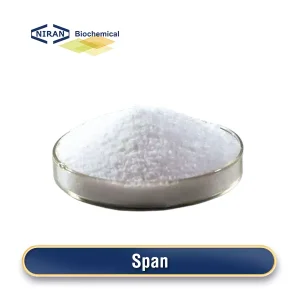What is Diacetyl Tartaric Acid Esters of Monoglycerides?
The food industry frequently uses diacetyl tartaric acid esters of monoglycerides as an emulsifier and stabilizer. It is mainly used in bread and baked products to improve dough stability, enhance gas retention, and improve food volume and texture.
DATEM, which is often a white powder, ensures the quality and flavor of baked goods by remaining stable at high temperatures and being difficult to break down.
In the food business, diacetyl tartaric acid esters of monoglycerides are frequently employed as stabilizers and emulsifiers. It is mainly used in bread and baked products to improve the stability of dough, enhance gas retention capacity, and improve the volume and texture of food.
DATEM, which is often a white powder, ensures the quality and flavor of baked goods by being stable at high temperatures and difficult to break down.
In China, the most common ways to prepare for DATEM are as follows:
- Acid-catalyzed esterification method
This is the most commonly used preparation method, which is to esterify monoglyceride with tartaric acid under the action of an acid catalyst. This method controls the reaction conditions (such as temperature, pressure, reaction time, etc.) during the preparation process to ensure the quality of the product. The acid-catalyzed esterification method has good reaction efficiency and high product purity. - Transesterification method
The transesterification method is another common preparation method. In this process, an intermediate product containing tartaric acid and glycerol is first prepared, and then converted into DATEM through an esterification reaction. This method is suitable for intermediates that have a certain esterification reaction and can improve the efficiency of the reaction. - Esterification-neutralization method
This method first generates a preliminary product through an esterification reaction, then removes unreacted raw materials and by-products through a neutralization reaction, and finally obtains DATEM. The esterification-neutralization method ensures the quality and stability of the product through two steps of separation and purification.
Related parameters:
Recommended dosage:
| Food name | Maximum usage(g/kg) |
| Baked goods | 0.5-1.0 g/kg |
| Cakes | 0.5-1.0 g/kg |
| Biscuits | 0.5-1.0 g/kg |
| Egg tarts | 0.5-1.0 g/kg |
| Puffs | 0.5-1.0 g/kg |
| Donuts | 0.5-1.0 g/kg |
| Fruit pies | 0.5-1.0 g/kg |
| Protein bars | 0.5-1.0 g/kg |
| Protein drinks | 0.5-1.0 g/kg |
| Bakery mixes | 0.5-1.0 g/kg |
| Dairy products | 0.5-1.0 g/kg |
| Cheese products | 0.5-1.0 g/kg |
| Ready-to-eat foods | 0.5-1.0 g/kg |
| Seasonings | 0.5-1.0 g/kg |
Diacetyl Tartaric Acid Esters of Monoglycerides has a wide range of uses
- Emulsification: DATEM is a highly effective emulsifier and stabilizer. Its core function is to stabilize emulsions, prevent oil-water stratification, enhance emulsification, and evenly distribute oil and water in food, thereby improving the taste and appearance of food.
- Dough stability: DATEM can significantly enhance the stability and mechanical properties of dough, improve gas retention capacity, and give bread and other baked products a larger volume and softer texture during fermentation and baking.It can prevent the dough from over-expanding or shrinking, thereby ensuring the quality consistency of the final product.
- Improve food quality: DATEM can also improve the quality of food, increase volume and density, make baked products such as bread and cakes more fluffy and uniform, and reduce the density and hardness of the product.
In addition, it can delay the staleness of food and maintain the freshness and softness of food.
User asked question:
Q: How does the use of DATEM affect the taste of food?
A: Diacetyl tartaric acid esters of monoglycerides can significantly improve the taste of food, mainly by enhancing the stability of the dough and the gas retention capacity, making baked goods such as bread and cakes softer and more delicate.
It improves the uniformity and texture of food, making each bite more consistent, while prolonging the freshness of food and reducing the risk of dryness and deterioration.
DATEM also prevents dough shrinkage, maintains the original shape and structure of the food, and further improves the overall taste and appearance of the food.

.webp)

-300x300.webp)

